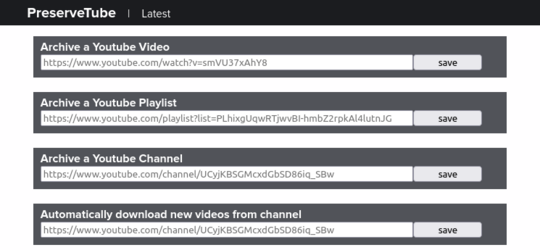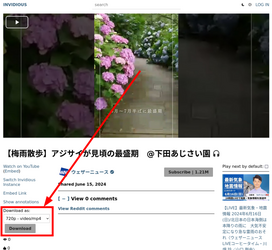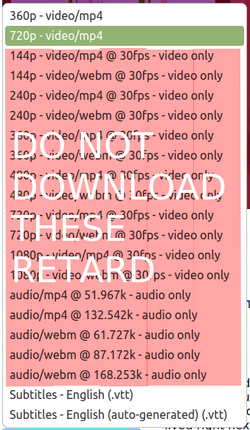How to archive YouTube videos
At this point here's my recommendation:
1. Use PreserveTube.com
It's free, run by a
Kiwi, does not use space on your computer/device, and can save single videos, playlists, and entire channels. And not only will it be saved for you but for everyone else as well.
Go there ASAP and submit your favorites, especially any lolcow channels that need preserving.
 2. Use websites and tools to download to your own computer/device
2. Use websites and tools to download to your own computer/device
If you have the storage space, you can download videos yourself.
If you're tech savvy:
- yt-dlp (youtube-dl is obsolete and no longer maintained, don't use it)
- Tube Archivist
- metube
If you're tech retarded:
- Google "download YouTube video" and use a website downloader. There's lots of them. This is fine for individual videos, but if you have a ton or a playlist/channel it'll be inconvenient, so use another method.
- Use the download option on public Invidious servers. SOME servers enable downloads, you will have to check servers to find them. Keep in mind random servers may have slow or unreliable connections.

- Pay attention and make sure you download one of the full video options (they should be first on the list) and not an audio-only or video-only option. Audio-only is obviously fine for music/podcasts (use an audio/mp4 option, bigger @ number = better audio quality). If you need another resolution that isn't available you'll have to use a different method (the GUI programs below might work), because these days YouTube separates audio and video into different files and combines them when you watch, and Invidious is too retarded to combine them for you.

- Use a GUI program. These are best for lots of videos/playlists/channels.
- Tartube (get the "and FFmpeg installer" version, you may need it)
- Stacher
- 4k Download
- Google "yt-dlp gui" and see what comes up.
Advice for download settings:
- If it asks for a format select mp4, that is the most common format used.
- If it lets you select a resolution (480p, 720p, 1080p, etc.) using a smaller resolution will save space.
- I recommend 480p for most content, unless the video contains content like text, on-screen chat in livestreams etc that can't be read. View the video after downloading to see if any text is readable, and if not redownload at a higher resolution.
- 720p may be better for livestreams if you want to preserve on-screen chat.
- 1080p or above may be best for some cow content for examining background details (inspecting the items in a filthy house, inspecting suspicious shadows that could suggest another person is present, things like that).
- It may be worthwhile to preserve cow content at 1080p or above just for the sake of having highest quality, but this will take a lot of space and may not be worthwhile unless you're going to share it.
3. Use Ghostarchive.org

ghostarchive.org
This archiver can sometimes save videos from YouTube pages, not just the page itself.
I don't know what quality it saves at however. There may also be limits on the size/length of videos that can be saved.
Best for individual videos you want preserved, like cow videos.
Q&A
1. I'll just use Invidious/FreeTube/Piped/NewPipe/SponserBlock/uBlock/YouTube alternative XYZ

The reason this is news worthy of a Feature on the Farms front page is because all of these might not be able to stop it. If this was something adblockers/alternatives could prevent nobody would give a shit and it wouldn't be newsworthy.
>Well I haven't seen any ads.
This is still being rolled out, just because you haven't seen any yet doesn't mean you won't see them eventually if Google goes forward with it.
>We can just mark where ads appear and remove them like SponserBlock
Ads can be inserted in random places
each time the video is viewed so this won't work. Ads will also be of different lengths, so even if an ad position is marked it may be a different length each time.
If you don't trust/believe me take it from slobbermutt:
The ad blocks will not be consistent or consistent times.
I think the people discussing adblockers don't seem to understand that no conventional adblocker will be able to adequately bypass ads once this change is implemented. As far as your computer is able to discern, the content you are watching is indistinguishable from the rest of the video. It is effectively lying to your computer as to what is ad and what is not ad. You will not be able to block it. Even if you had AI that could detect the interruption for you, the best it will be able to do is simply mute and black out until the ad has finished playing.
And really, if they're that dedicated, more sophisticated tools could be detected. Even if it were something really magic like being able to download the next sequence of the video from a remote server and play it instead, YouTube would be able to tell that your player is now acting as if the ad never played, and it could break itself.
2. This will introduce security risks
Performing on the fly code injections on youtube videos seems like a real good way for some advertisers to hack peoples devices
How long until someone discovers a security risk in how youtube bakes ads into the video? Prepare for Video SQL injection.
There seems to be some confusion because we're using the term "inject" to describe this, but
this is not code injection. YouTube is inserting
videos into YouTube videos,
not code or the kinds of ads on the sides of pages.
It's the equivalent of opening the videos in a video editor and inserting the ad video clip in the middle. The entire thing is still just a video, but with video ads inserted. But instead of doing it by hand in a video editor, Google is automating it on the fly with a program when each person watches a video.
Or to put it another way, it's like ads on cable TV. They're video ads edited into the middle of videos the way television ads were edited into cable TV shows.
(The way ads worked previously on YouTube is they were
not part of the video itself, they were entirely separate, and YouTube would
pause the video you were watching and show them "on top" of the video. Adblockers worked by identifying these separate files and preventing them from being downloaded or displayed.)
3. But inserting ads requires encoding/is computationally difficult/etc.
Videos are a series of data chunks. Video data can be inserted between these chunks with almost no effort at all. It does not require re-encoding.
4. Just use tools to identify the ads in video and remove them.
MythTV developed a way of skipping TV ads ages ago. Hopefully the better youtube channels will start putting a logo in the corner to make this easy.
Has anyone posted screenshots of what the embedded ads actually look like? I wonder how hard it would be to train something like CLIP to recognize ad frames and block them. Or maybe not even CLIP, maybe just a more low-tech image recognition thing.
and filter out any parts which deviate from that data, thereby negating this newest YouTube faggotry?
This is a possibility, but the problem is whether such a tool can reliably differentiate between a video's content and ad content. Given how varied video content can be there's no guarantee this can be done reliably and may generate false positives.
5. So we're fucked?
Never underestimate the power of autism to overcome a problem like this, but don't put absolute faith in it being solved either.





